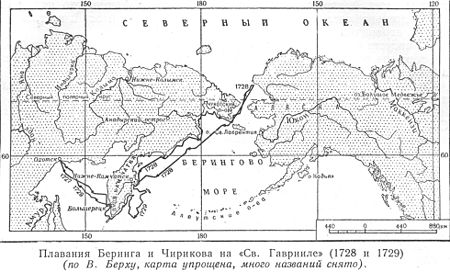
The First Kamchatka Expedition was the first Russian expedition to explore the Asian Pacific coast. It was commissioned by Peter the Great in 1724 and was led by Vitus Bering. Afield from 1725 to 1731, it was Russia's first naval scientific expedition.[1] It confirmed the presence of a strait (now known as Bering Strait) between Asia and America and was followed in 1732 by the Second Kamchatka Expedition.
The expedition spent first two years, from January 1725 to January 1727, on traveling from Saint Petersburg to Okhotsk, using horses, dog sleds and river boats. After wintering in Okhotsk it moved to the mouth of the Kamchatka River on the east coast of the peninsula. In July–August 1728 it sailed north and then north-east along the shore, exploring Karaginsky Gulf, Kresta Bay, Providence Bay, Gulf of Anadyr, Cape Chukotsky, and St. Lawrence Island.
The expedition, as it turned out, went through the Bering Strait to the Chukchi Sea, and returned believing that it had completed its tasks. While it had not reached the North American coast, it provided evidence that Asia and North America are not connected. During 1729, it explored the southern shores of Kamchatka, mapping Avacha Bay, and by 28 February 1730 returned via Okhotsk to Saint Petersburg. The expedition was highly praised, with its leader Vitus Bering being promoted to captain-commander, his first noble rank, whereas his assistants Martin Spanberg and Aleksei Chirikov were made captains. It had been a long and expensive expedition, costing 15 men and souring relations between Russia and her native peoples, but it had provided useful insights into the geography of Eastern Siberia: in total the expedition surveyed more than 3500 km of the western coast of the sea, which was later named after Bering. Its maps of the area were later used by all Western European cartographers.